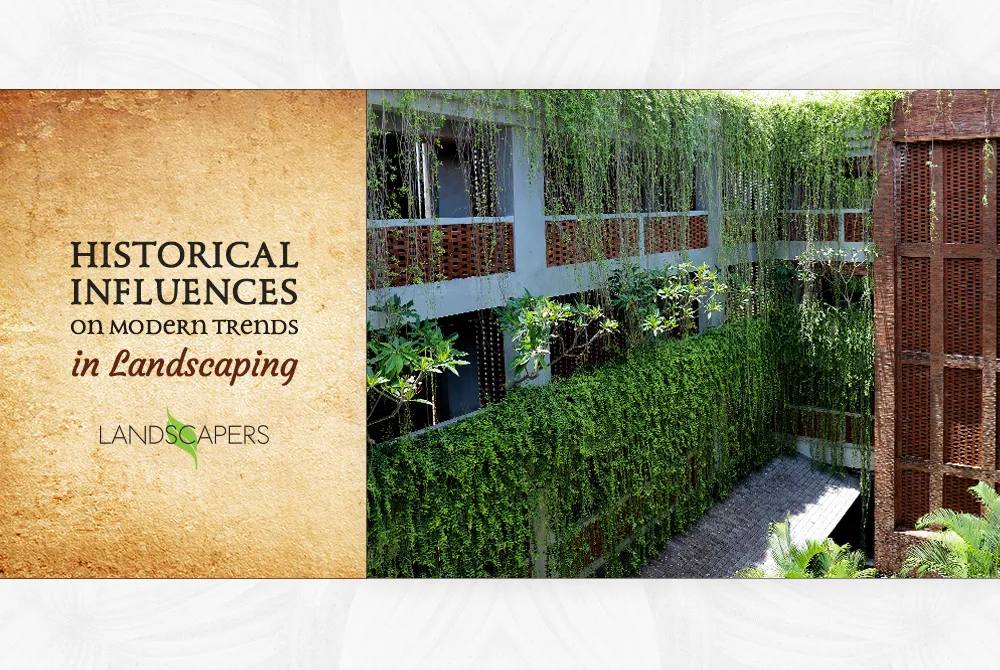
Historical Influences on Modern Trends in Landscaping
Landscaping as an architectural feat has always existed in some shape or form. It is the builder’s way of giving tribute to something that they hold dear, be it a particular style of construction and architecture, a simple method of incorporating greenery to break the monotony of the concrete and steel structure, or a way in which landscapers draw inspiration from subtly nuanced details contained within classical or traditional landscaping projects. The most notable of such projects would be the Hanging Gardens of Babylon, one of the seven wonders of the ancient world.
However, those weren’t the only architectural marvels that imprinted on the minds of modern-day landscapers and architects. Like any other form of art, landscaping does not exist in a vacuum. It is deeply rooted in the past, and many of today’s modern landscaping trends bear the indelible mark of historical influences. Let’s journey back in time and explore how ancient garden designs and cultural aesthetics have paved the path for modern landscape design. Let’s take a look back on some of the major incidents that helped shape the modern landscaping scene to be the way we see it now:
Ancient Greece and its classical gardens have undoubtedly left a deep mark on modern landscaping. The Greeks held a deep admiration for order, symmetry and balance, which can be clearly recognized in the geometric layouts, neat lines and structure found in many contemporary designs.
As we move further east towards China and Japan, their traditional zen gardens offer a far more well-defined ideology. Rather than dominating nature using lines and structure as in Western designs, Eastern gardens flow with nature, harmonizing as one. In Eastern gardens, the free-flowing harmonious approach often adds authenticity to modern landscaping projects. Every rock, pool, pond and plant is carefully arranged in a manner that they work together to represent a larger nature scene.
Then followed the French Renaissance, otherwise simply referred to as the Renaissance, a time when classical techniques of art and culture were being revived. Gardens designed during the Renaissance were the perfect combination of botany, architecture and sculpture. They showcased a variety of blends of art and nature, a trend which is now quite common in modern landscaping designs. Nowadays, gardens will often act as an extension of the living space, combining the outdoors with the indoors.
Next we move to Europe to look at the tradition of the formal gardens of France, the best example of which is perhaps the Gardens of Versailles. The Gardens highlight symmetry, strict geometry, and a very distinct dominance over natural beauty. Any urban space that requires structure when it is appearing to be haphazard and chaotic can do better if a French formal garden style is maintained.
A major shift in landscaping design took place when the Industrial Revolution began to transform the global economy and mindsets of people. As it gave rise to the classes of bourgeoisie and the newly evolving working class, landscaping projects of the time would reflect the sensibilities of the time. As industrialization led to “Urbanization”, availability of green spaces became far more limited than before, which is around the same time that concept landscaping started to come up as an idea.
Concept landscaping was an effort to increase greenery in urban settings in the form of vertical green walls, rooftop gardens, and even resting areas interspersed throughout buildings. Modern landscaping also uses pavement tiles or paving to connect nature with structure and form. Creating paths allows us to perhaps walk in spaces that were previously untouched, scratching that age-old itch we humans had of conquering the unknown. Paving can also often be strategically placed to give people a momentary reprieve away from the chaos of mundane life.
Maintaining a sense of harmony between function and beauty is pivotal, ensuring every step within a designed space is as secure as it is visually pleasing. Add to this the play of colours and the integration of natural elements, and you have a symphony of the past and present ready at your fingertips. Along with enhancing the aesthetics and safety of a space, modern-day paving also aligns with sustainable landscape management practices. This sustainable approach to paving ensures that landscapes are not only beautiful and safe but also environmentally responsible.
The beauty of landscaping does not only come from modern techniques, but we also draw inspiration (where possible) from historical influences–especially where we can use the positive ideas combined with the modern methods to create spaces that are functional, beautiful and use sustainable materials at the same time.

